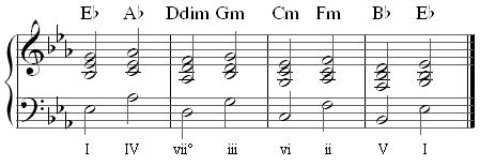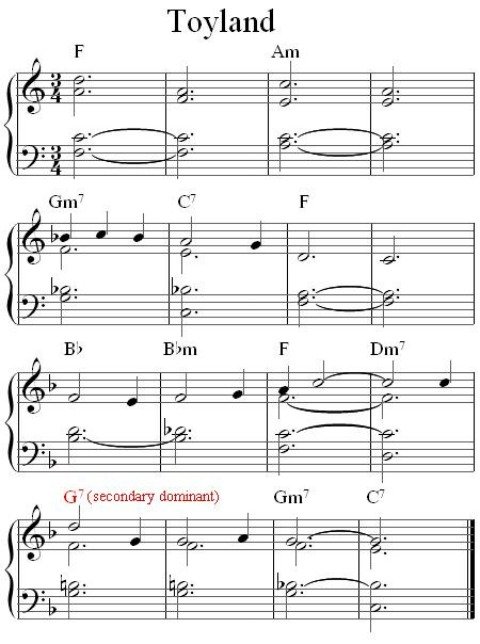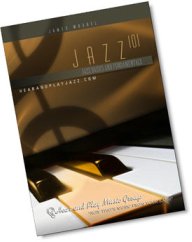Secondary Chords
Chord Progressions vii - iii - vi - ii
Secondary Chords add flavor and spice to the music - they expand the harmonic structure and help create the mood...
... these are the ii - iii - vi and vii° chords...
They are built on the second, third, sixth and seventh degrees of a diatonic scale.
Here they are in the key of C major:

Here they are in the key of Eb major:

If we follow the movement of the Circle of 5ths, we will get a good idea of how harmony can logically progress through the primary and secondary chords... (as a matter of fact, through all chords.)
Following the Circle, counterclockwise, the chord movement of up a 4th - down a 5th - up a 4th - down a 5th etc... makes perfect sense to our ears - it is a logical, satisfying sound.
The reasons for this natural phenomenon venture into the world of ACOUSTICS, which is WAY BEYOND THE SCOPE of this website. It's just mentioned here as a reference.
The following example demonstrates the up a 4th - down a 5th - up a 4th - down a 5th movement of the Circle of 5ths. This example just uses the diatonic triads in the key of Eb major.

Now let's add a little spice to that example!
This demonstrates the same harmonic movement, but uses diatonic 7ths in the key of Eb major.

Notice how the use of the diatonic 7ths changed the overall style of that example? It gave it a slightly more mellow, "contemporary" sound.
Go here for a quick review of DIATONIC 7th CHORDS.
FREE DOWNLOAD: Seventh chords!
Click the icon to download s free PDF of ALL 7th, minor 7th and major 7th CHORDS. You can then save a copy or print a hard copy of the included sheet.
Harmony and Theory: A Comprehensive Source for All Musicians (Musicians Institute) by Carl Schroeder and Keith Wyatt.
For a comprehensive, concise reference about primary chords, secondary chords & chord progressions, this book is a "MUST HAVE".
Here is part of a review of this book by Patrick D. Goonan ... The review is from: Harmony and Theory: A Comprehensive Source for All Musicians (Essential Concepts (Musicians Institute).
"...I absolutely love this book. It covers essential music theory is a very short space in a well-organized manner. More importantly, it emphasizes the concepts that are most important to a musician who wants to develop their practical skills at chord substitution, improvisation, voicing chords, etc..."
Toyland
Below is an excerpt from a Christmas song, Toyland. It uses primary and secondary chords, some diatonic 7ths and something new, a secondary dominant7.

The G7 chord in Toyland is a secondary dominant chord. The song is in the Key of F (Bb is in the key signature.) So the ii chord or ii7 chord would normally be Gm or Gm7. Right??
HOWEVER, in this case there is a B natural in the G7 chord.
This keeps the 7th as a minor interval BUT it makes the G triad major instead of minor. It changes the quality... it's no longer a diatonic 7th,
it's a dominant 7th or secondary dominant.
7th chords - chord inversions - sus chords
extended chords - diatonic triads - diatonic 7th chords
primary chords - secondary chords - secondary dominants
THE COMPLETE
ONLINE BUSINESS BUILDER
SBI
Hi and Welcome!
Fill out the form below to sign up for the free periodic
Player's Guide Newsletter!
Get tips and ideas about substitute chords, chord progressions and harmonic movement.
What's this???
The Complete book of:
Scales, Chords,
Arpeggios & Cadences
Harmony and Theory:
by Carl Schroeder and Keith Wyatt






New! Comments
Please leave me a comment in the box below.